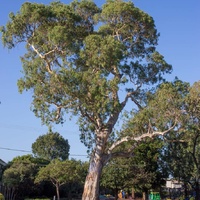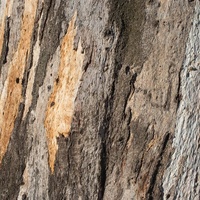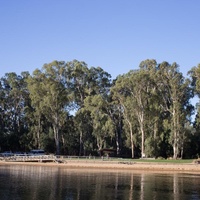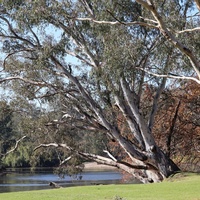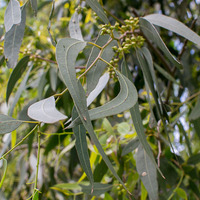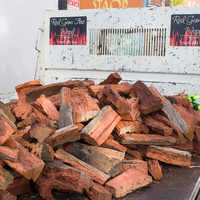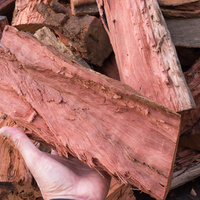Common name: Red gum
Other common names: Murray red gum, River red gum
Description
Red Gum produces valuable timber and fuelwood and is Australia's most widely distributed eucalyptus tree species, its natural range extending over much of the continent. However, trees from tropical, subtropical, temperate and arid regions are usually treated as distinct varieties, because of variation in their form, climate adaptation and tolerance to extreme conditions.
Depending on the variety, it is a medium-sized to large tree with subtropical varieties reaching up to 40 m (130 ft) tall, almost twice as tall as tropical varieties. However, 15 to 25 m (50 to 82 ft) is more commonly the height in cultivation. A fast-growing tree under ideal conditions, it may achieve a growth rate of up to 2 m (7 ft) in height per year.
The trunk is usually straight, stout on subtropical varieties with flaking mottled grey bark and on tropical varieties, slender with smooth whitish bark, sometimes mottled by reddish-brown patches. The branches are few and ascending, forming an open, rounded, moderately leafy crown.
The leaves and flowers are typical of Eucalyptus species. The leaves long, narrow, slightly curved or sometimes straight and green or blue-green. The flowers small, with erect creamy-white filaments, blooming from spring to early summer. Fertilised flowers develop into small bowl-shaped seed capsules containing pyramid- or cube-shaped seed.
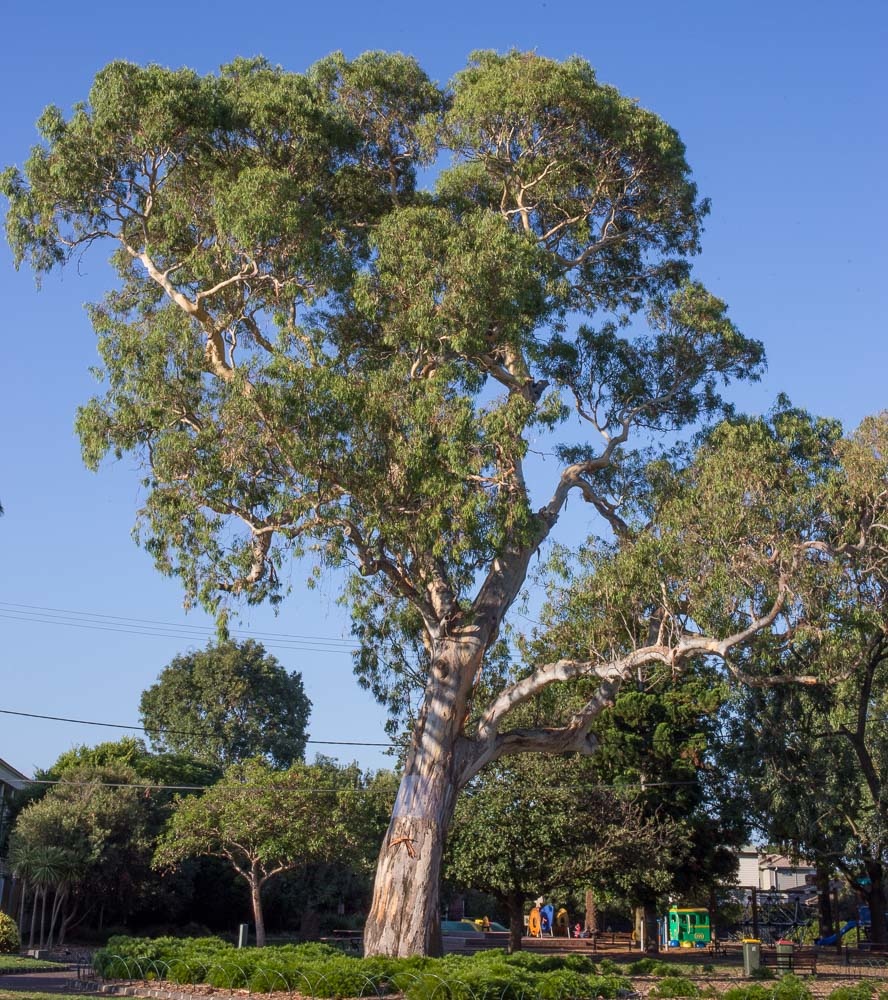
St Kilda, Victoria, Australia
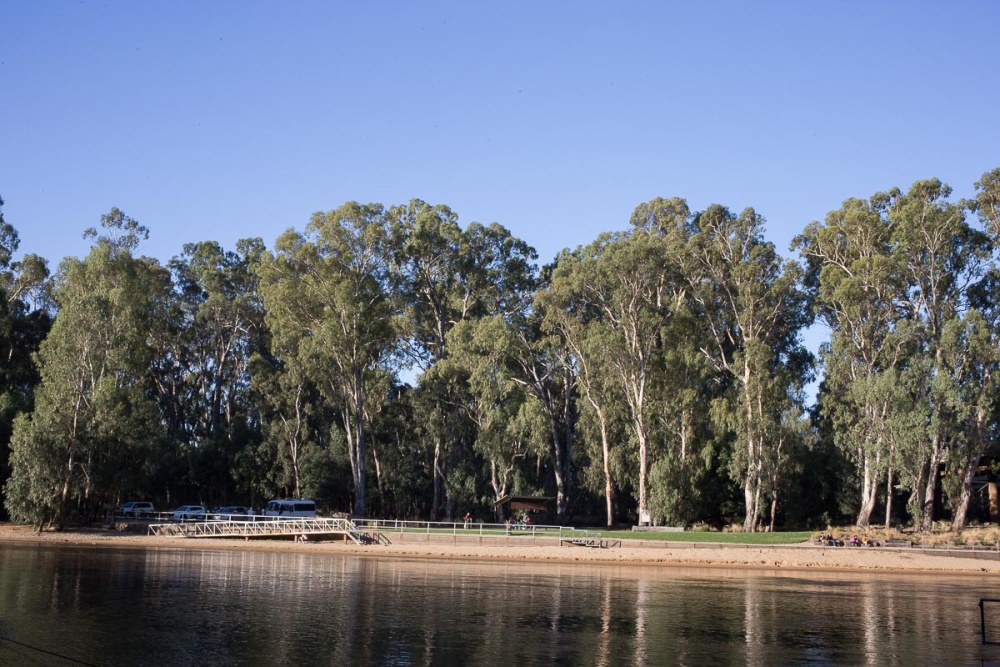
Red Gums on the Murray River in Australia
Use
Red Gum produces a heavy wood in the 750 to 950 kgs per cubic meter (47 to 59 lbs per cubic ft) range, with medium to high natural resistance to decay and termites. This puts it in the durable hardwood class, making it suitable for indoor and outdoor construction. The heartwood is an attractive reddish-brown.
Suitable logs are sawn into beams and planks used in general construction, flooring, outdoor decking, furniture, and cabinets. However, it needs to be seasoned slowly, as it tends to warp badly if not.
The small-diameter roundwood is cut for transmission poles, fence posts, and turnery and processing into plywood and pulp used in paper manufacture.
Irregularly-shaped logs are cut for firewood and for making charcoal. And because it is a fast-growing tree and coppices well (re-grows after being cut back to ground level), it is widely cultivated for this purpose.
The flowers are a major source of pollen and nectar for honeybees, with honey production per colony over a regular flowering season averaging 50 to 60 kgs (110 to 132 lbs). The honey is bright to pale amber, dense, with a pleasing mild fruity, woody flavour and is slow to granulate.
The leaves of some varieties yield an essential oil extracted commercially by steam distillation. Commonly traded as 'Eucalyptus oil', it is generally used in cleaning and disinfecting products, medicinal preparations and pharmaceuticals. Eucalyptus oil is also used as a stain remover, having proven effective in removing grease, glue and dried stains from both skin and clothing.
Red gum leaves are also a primary food source of Australian koalas, together with those of Blue Gum (Eucalyptus tereticornis) and Swamp Mahogany (Eucalyptus robusta).
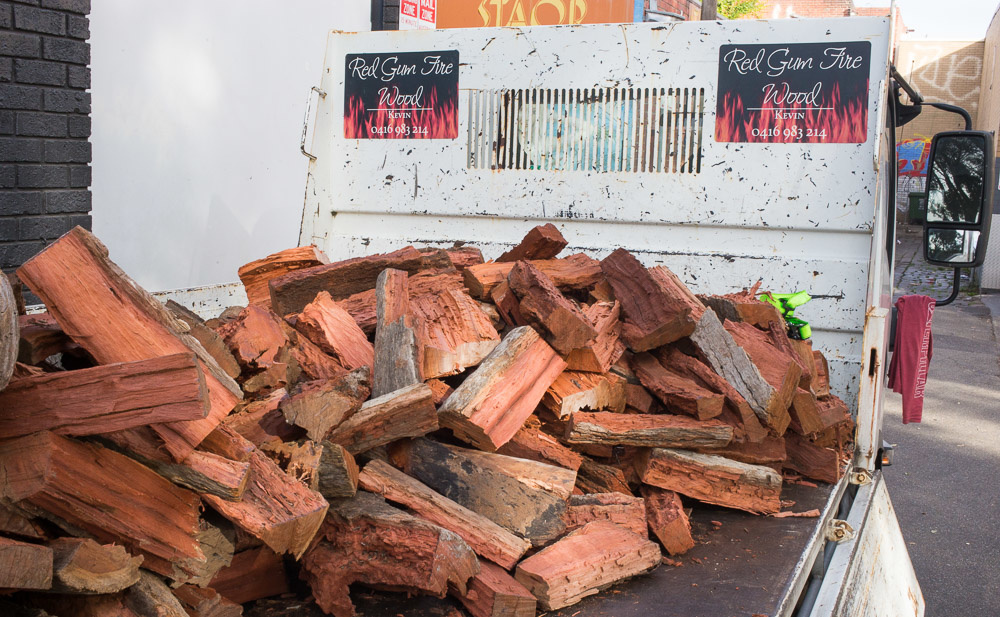
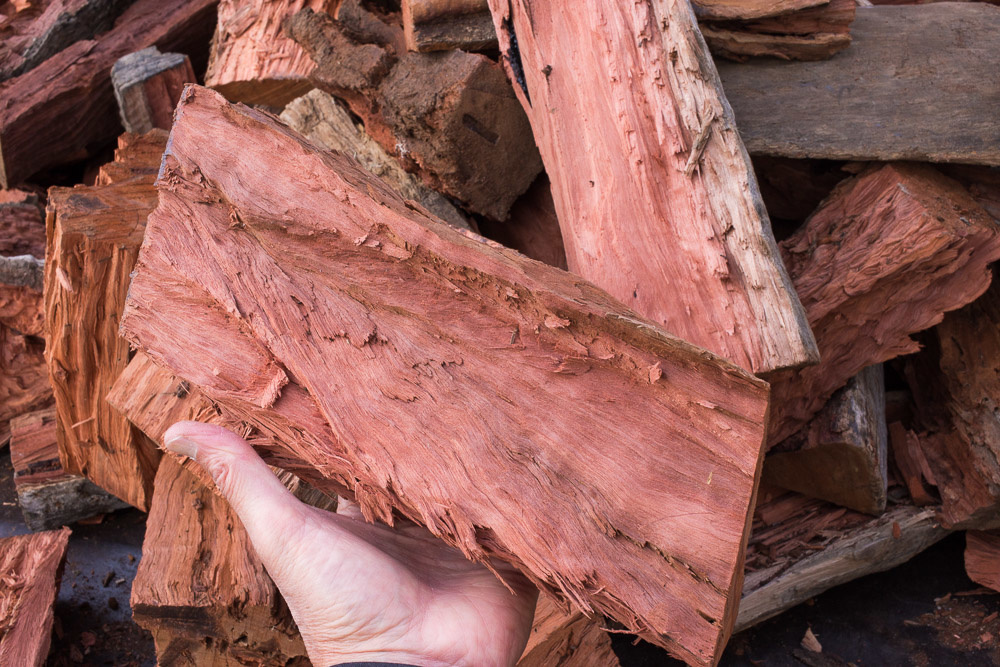
Red Gum firewood
Climate
Red Gum grows naturally and has its best development in sub-humid to humid warm-temperate, subtropical and tropical climates, generally areas with annual lows of 7 to 25°C, annual highs of 17 to 36°C, annual rainfall of 500 to 2500 mm and a dry season of 2 to 8 months, extending to 12 months with irrigation.
Although parts of its natural range receive less than 500 mm annual rainfall, the trees there occur mainly in isolated stands along dry riverbeds or water-courses, where the deep roots have year-round access to groundwater.
Growing
New plants are usually started from seed, which remain viable for several years if stored under cold, dry, airtight conditions. Seedlings germinate within a week or two of sowing and can be transplanted to the field when they are about six months old.
Once established, red gum trees perform well on a variety of free-draining clay-loam, loam, sandy-loam and loamy-sand soils of a moderately acid to alkaline nature, generally with a pH of 6.0 to 8.0, and on sites with full sun exposure. It has good tolerance to drought, seasonal flooding and a slight tolerance to salt, with growth reportedly unaffected in soils with salt concentrations equivalent to 3.2 grams of dissolved salt per litre of water.
Problem features
The seed are small and easily dispersed. It is recorded as a weed in South Africa and Jamaica and is assessed as a high weed risk species for Florida by the IFAS Assessment of Non-Native Plants in Florida's Natural Areas.
The branches are brittle, with a tendency to break off in heavy winds, potentially causing personal injury or damage to property. The roots are reported to be strongly vigorous and can cause damage to building foundations as well as underground pipes. Because of this, it is not recommended for planting in home gardens.
Prolonged skin contact with Eucalyptus essential oil may cause burning dermatitis and blisters in some people, and it can be poisonous if ingested in large amounts.
Where it grows
References
Books
-
Berni, C. A & Bolza, E. & Christensen, F. J. 1979, South American timbers - the characteristics, properties and uses of 190 species, Commonwealth Scientific and Industrial Research Organization (CSIRO), Division of Building Research, Highett, Victoria, Australia
-
Blake, S. T. & Roff, C. 1987, The honey flora of Queensland, 3rd ed., Queensland Department of Primary Industries (QLD DPI), Brisbane
-
Boland D.J., Brophy J.J. & House A. P. N. 1991, Eucalyptus leaf oils, use, chemistry, distillation and marketing, Australian Centre for International Agricultural Research (ACIAR) & Commonwealth Scientific Industrial Research(CSIRO), Inkata Press, Melbourne
-
Boland, D. & Brooker, I. & McDonald, M. W. 2006, Forest trees of Australia, 5th ed., CSIRO Publishing (Ensis), Melbourne
-
C.A.B. International 2013, The CABI encyclopedia of forest trees, CABI Publishing, Wallingford, Oxfordshire
-
Clarke, B. & McLeod, I. & Vercoe, T. 2009, Trees for farm Forestry : 22 Promising Species, Rural Industries Research and Development Corporation (RIRDC), Wagga Wagga, New South Wales
-
Crane, E., Walker, P. & Day, R. 1984, Directory of important world honey sources, International Bee Research Association, London
-
Doran, J. C & Turnbull, J. W. 1997, Australian trees and shrubs : species for land rehabilitation and farm planting in the tropics, 2nd ed, Australian Centre for International Agricultural Research (ACIAR), Canberra, Australian Capital Territory
-
F. R. Beuhne 1922, Honey flora of Victoria, Melbourne Albert J. Mullett, Govt. printer
-
Hocking, D. 1993, Trees for drylands, International Science Publisher, New York
-
Holliday, I. 2002, A field guide to Australian trees, 3rd revised editon, New Holland Publishers, Frenchs Forest, New South Wales
-
Jensen, M. 1999, Trees commonly cultivated in Southeast Asia : an illustrated field guide, 2nd ed., Food and Agricultural Organisation of the United Nations (FAO) Regional Office for Asia and the Pacific (RAP), Bangkok
-
Krishen, P. 2006, Trees of Delhi : a field guide, Dorling Kindersley Publishers, Delhi
-
Leech, M. 2013, Bee Friendly: A planting guide for European honeybees and Australian native pollinators, Rural Industries Research and Development Corporation (RIRDC), Canberra, Australian Capital Territory
-
Liegel, L. H. 1987. A technical guide for forest nursery management in the Caribbean and Latin America, U.S. Dept. of Agriculture, Forest Service, Southern Forest Experiment Station, New Orleans
-
Little, E. L. & Skolmen, R. G. 1989, Common forest trees of Hawaii (native and introduced), Agricultuural Handbook No. 679, Forest Service, U.S. Department of Agriculture, Washington, D.C.
-
Luna, R. K 1996, Plantation trees, International Book Distributors, Dehradun, Uttarakhand
-
Maesen, L. J. G. van der & Faridah Hanum, I & Prosea Project 1997, Auxiliary plants, Backhuys Publishers, Leiden
-
Marcar, N. E. 1995, Trees for saltland : a guide to selecting native species for Australia, Division of Forestry, Commonwealth Scientific and Industrial Research Organisation (CSIRO) Australia, Canberra
-
National Research Council (Board on Science and Technology for International Development) 1980, Firewood crops : shrub and tree species for energy production (Volume 1), The National Academies Press, Washington D. C.
-
Perry, B. 2010, Landscape plants for California gardens: an illustrated reference of plants for California landscapes, Land Design Publishing, Claremont, California
-
Porter, T. 2012, Wood : identification & use, Compact edition, Guild of Master Craftsman Publications, Lewes, East Sussex
-
Randall, R. P. 2002, A global compendium of weeds, R.G. and F.J. Richardson Press, Melbourne
-
Scheffer, T. C & Morrell, J. J. 1998, Natural durability of wood : a worldwide checklist of species, Forest Research Laboratory, Oregon State University, Corvallis, Oregon
-
Sheikh M. I. 1993, Trees of Pakistan, USAID Forestry Planning and Development Project, Pictorial Printers, Islamabad
-
Webb, D. B. 1984, A Guide to species selection for tropical and sub-tropical plantations, 2nd ed., Unit of Tropical Silviculture, Commonwealth Forestry Institute, University of Oxford, Oxfordshire
Articles, Journals, Reports and Working Papers
-
National Research Council (Board on Science and Technology for International Development) 1990, Saline agriculture : salt-tolerant plants for developing countries, The National Academies Press, Washington D. C.
